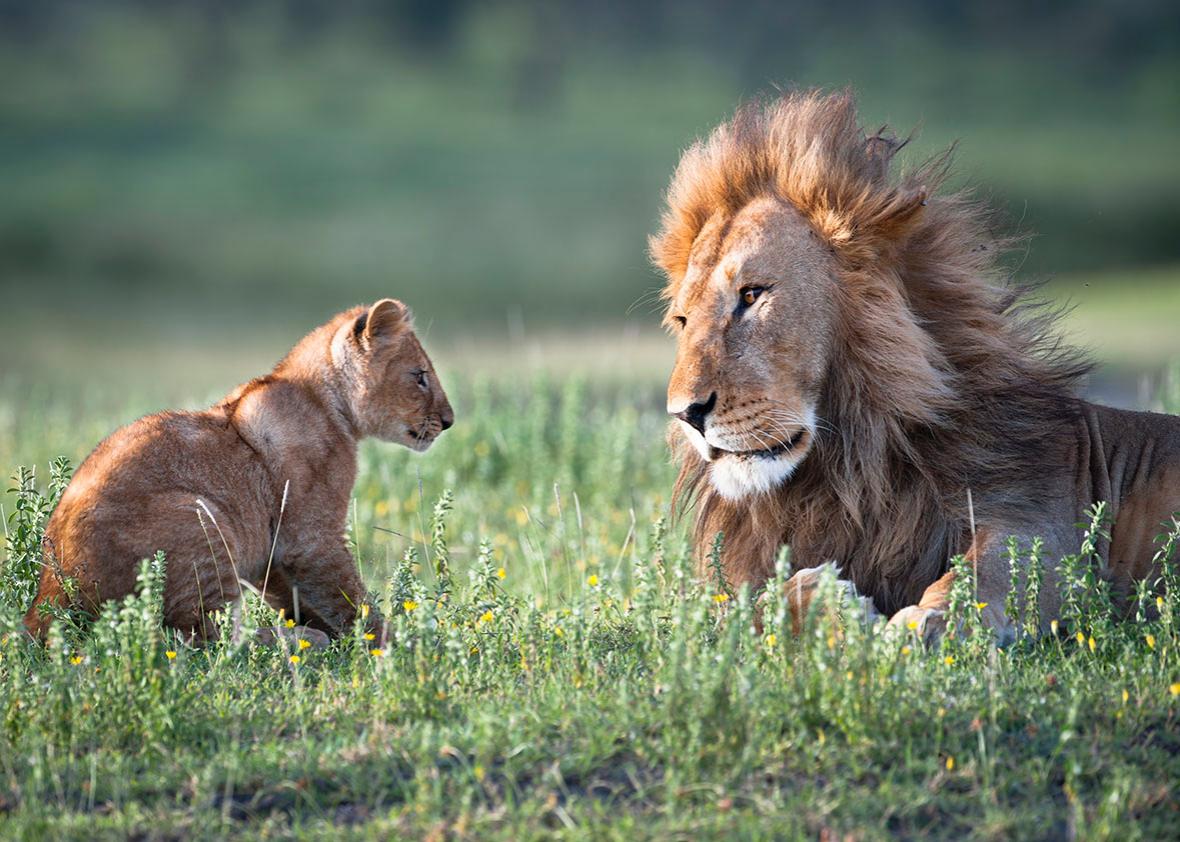An American hunter became the world’s most hated dentist in a matter of days, after he allegedly baited, wounded with a bow and arrow, stalked, shot with a gun, decapitated, and skinned a 13-year-old black mane lion named Cecil. But Walter Palmer, whereabouts unknown, is not the only person to stalk and kill a lion in Africa recently—not even close.
Every year, foreign hunters export the carcasses (usually just the head and hide) of 665 wild lions from Africa—an average of nearly two lions each day. In Zimbabwe, the country where Cecil was killed, hunters exported 49 lion trophies in 2013 alone. Since Cecil’s death in early July, it’s likely that at least a dozen other lions have been shot by trophy hunters.
Palmer is no newcomer to the hunting scene: He has shared photos of himself grinning with the carcasses of a leopard, bighorn sheep, polar bear, moose, elk, buffalo, and another lion. He even pleaded guilty to lying to federal wildlife officials about exactly where he killed a black bear during a hunt in Wisconsin in 2008.
But the recent news of Palmer’s kill, for which he allegedly paid $55,000, and the gruesome story that accompanied it, hit a nerve this week. Cecil was one of Africa’s most famous lions and a study subject for an Oxford University research project meant to examine hunting’s impact in Hwange National Park. As of now, the research has found that 34 of 62 tagged lions died during the study period. Of these, 24 were shot by sport hunters.
It doesn’t help Palmer’s image that lions in particular are struggling to survive in Africa. A century ago, there were some 200,000 African lions prowling the savannah. Now, according to the last complete assessment in 2012, there are as few as 32,000 left, living on less than 20 percent of the land they used to roam. They’re considered “‘vulnerable” by the IUCN Red List, and last October the U.S. Fish and Wildlife Service proposed to list the species as “threatened” under the Endangered Species Act.
But as is true for almost any dwindling resource, rarity begets value. Trophy hunting for lions has increased in recent decades, mostly in the southern and eastern regions of the continent, in Mozambique, Botswana, Zambia, Namibia, South Africa, Zimbabwe, and Tanzania, a country that contains about half of Africa’s lions. None of these countries have exceeded a 6 percent “take” limit recommended by the World Wildlife Fund—meaning that none have hunted so many lions that 6 percent of the population is killed in one year.
But that’s not to say that trophy hunting has no impact. In Zimbabwe, lion trophy hunts were banned from 2005 to 2008, after scientists warned that hunting had hurt the population. At least one study has demonstrated that trophy hunting “is impacting negatively on some lion populations.”
Despite this, many hunters and even some researchers argue that trophy hunting, at its core a rich man’s sport, can funnel money into local communities and fund critical conservation initiatives. The trophy hunting business is roaring, especially for the “big five” (lions, elephants, Cape buffalo, leopards, and rhinos). In sub-Saharan Africa, 5,382,265 square miles of land are used for hunting tourism—a larger area than that encompassed by national parks. And lion hunts, ranging in price from $24,000 to $71,000 a pop, attract the highest mean prices of any trophy species.
That being said, the theory that money from trophy hunting goes directly into communities and conservation is questionable at best. Research published by the pro-hunting International Council for Game and Wildlife Conservation and the U.N. Food and Agriculture Organization found that that hunting companies contribute only 3 percent of their revenue to communities living in hunting areas. And according to a 2013 report by the International Fund for Animal Welfare, trophy hunting accounts for 0.27 percent or less of the GDP of each African country in which it’s conducted.
Regardless of its value, or lack thereof, the history of big-name trophy hunting is long and achingly repetitive. Every few months, another story, accompanied by the grisly photos, pops up, and outrage ensues. From the Texas cheerleader who gunned down an elephant, leopard, and rhino, to the millionaire (also from Texas) who shelled out $350,000 to kill an endangered black rhino, to Sarah Palin’s memorable hunting quotes, the Internet is lightning fast when it comes to calling out wildlife killers, often trailing hordes of trolls and death threats.
In this case, Palmer has faced a virtual avalanche of online fury—despite a flat apology, his Yelp page is a disaster, and his dental practice’s Facebook page and website have gone dark. News crews and angry mobs surrounded his Minneapolis practice, which has remained shuttered.
Oddly enough, the public meltdown united public figures from across the political and social spectrum, from Jimmy Kimmel (“vomitous”) to Lennox Lewis (“sick”) to Newt Gingrich (“the entire team … should go to jail”) to Ricky Gervais (“mental”), among others. Many have called for his prosecution in the U.S. or for him to be extradited to be charged in Zimbabwe.
It’s now abundantly clear that people detest hunters who shoot rare wild animals for sport. Palmer, however, hasn’t gotten the message, calling trophy hunting “an activity I love” in a statement, even with his livelihood, reputation, and freedom threatened.
One good thing may come out of the whole ordeal, though. For other would-be big game hunters, Palmer has become the perfect example of what not to do.
